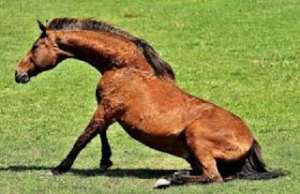
In Germany, military horses came down with the anemia virus towards the end of World War I, in horse sick-bays. The rapid spread led one to conclude that intentional causes were involved, even though the official version was supposed to make it look as if natural causes had occurred.
In reality, the mass slaughter of EIAV-infected horses was not for purposes of fighting the epidemic but rather to obtain the virus of Infectious Anemia of Horses which were then to be exposed to enemy animal stocks and later were tested on persons.
Early in 1917, some horses were admitted to the Tilsit horse sick-bays (in East Prussia at that time) allegedly to undergo treatment for skin-parasites. However, shortly afterwards, they were slaughtered because of "frailness, weight-loss, and intermittent fever."
The diagnosis of Infectious Anemia originated from the then head of the Animal Epidemics research Center in Pojeziory, Russia, Luhrs. A couple of weeks later, 143 out of 336 horses died in the Buk horse sick-bay near Possen (Prussia at that time) with Infectious Anemia of Horses.
In the middle of 1917, several animals died in the horse sick-bay at Verdun, and starting September 1917, 292 out of 524 "fairly well-fed" horses also died in the horse sick-bay in the Department of Les Ardennes. "The question, as to how it was possible that 55.73% of the entire stock should be infected with Infectious Anemia could not be explained," was the statement in a report.
The possibility of infection through syringes was expressly repudiated in this report. The research director of the Animal Epidemic Center, West, Rheinhardt, reported on measures to "remove the slaughtered and sick animals," among other things "collecting blood and storing it in buckets for purposes of proper disposal.
The Berlin Reichs ministry of defence regretted in its Bulletin that it was not as yet established as to "how this infection naturally occurs." But it warns against the explosive occurrence of a widespread number of diseases," without, however, mentioning that all infections to date had occurred in horse sick-bays.
According to official information, during the period from June 1917 to August 1918, 27,802 German military horses were infected with Infectious Anemia of Horses, of which 5,308 died. The end of the World War I, also saw the alleged end of the Infectious Anemia of 'military) Horses-infections.
Luhrs, who still registered 251 cases in 1920, where military horses died from Infectious Anemia Horses, only reported on 12 cases in 1922. In 1923, there was not one instance of infection registered among military horses.




 Dumsor: Don't rush to demand timetable; the problem may be temporary — Atik Moha...
Dumsor: Don't rush to demand timetable; the problem may be temporary — Atik Moha...
 Space X Starlink’s satellite broadband approved in Ghana — NCA
Space X Starlink’s satellite broadband approved in Ghana — NCA
 2024 election will be decided on the grounds of the economy; choice of running m...
2024 election will be decided on the grounds of the economy; choice of running m...
 Dumsor: We're demanding less; just give us a timetable — Kwesi Pratt to ECG
Dumsor: We're demanding less; just give us a timetable — Kwesi Pratt to ECG
 Do I have to apologise for doing my security work, I won’t – Simon Osei-Mensah r...
Do I have to apologise for doing my security work, I won’t – Simon Osei-Mensah r...
 All my businesses have collapsed under Akufo-Addo — NDC Central regional chair
All my businesses have collapsed under Akufo-Addo — NDC Central regional chair
 Military, Prison Officers clash in Bawku, three injured
Military, Prison Officers clash in Bawku, three injured
 GRA-SML contract: MFWA files RTI request demanding KPMG report
GRA-SML contract: MFWA files RTI request demanding KPMG report
 Court threatens to call second accused to testify if NDC's Ofosu Ampofo fails to...
Court threatens to call second accused to testify if NDC's Ofosu Ampofo fails to...
 Family accuses hospital of medical negligence, extortion in death of 17-year-old...
Family accuses hospital of medical negligence, extortion in death of 17-year-old...
